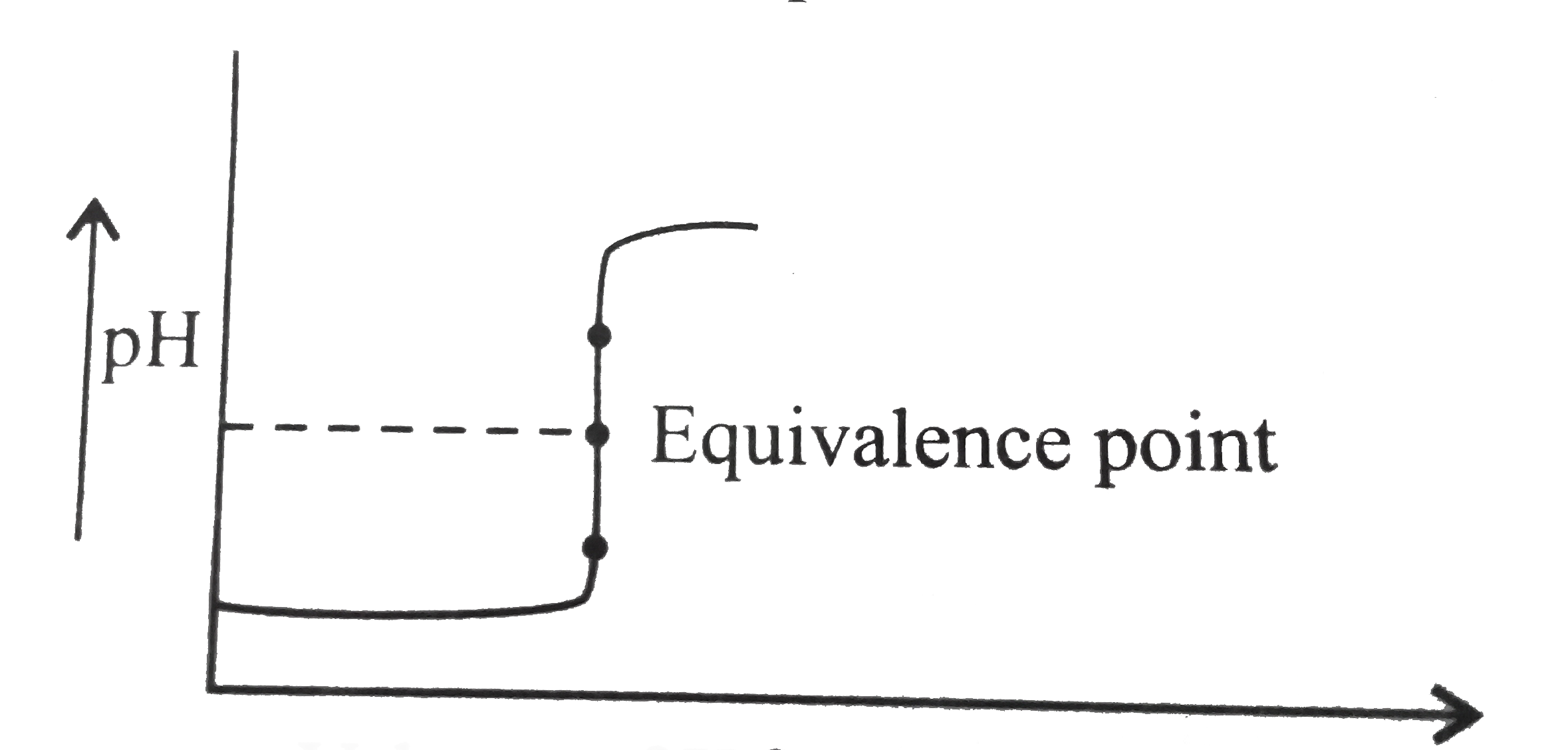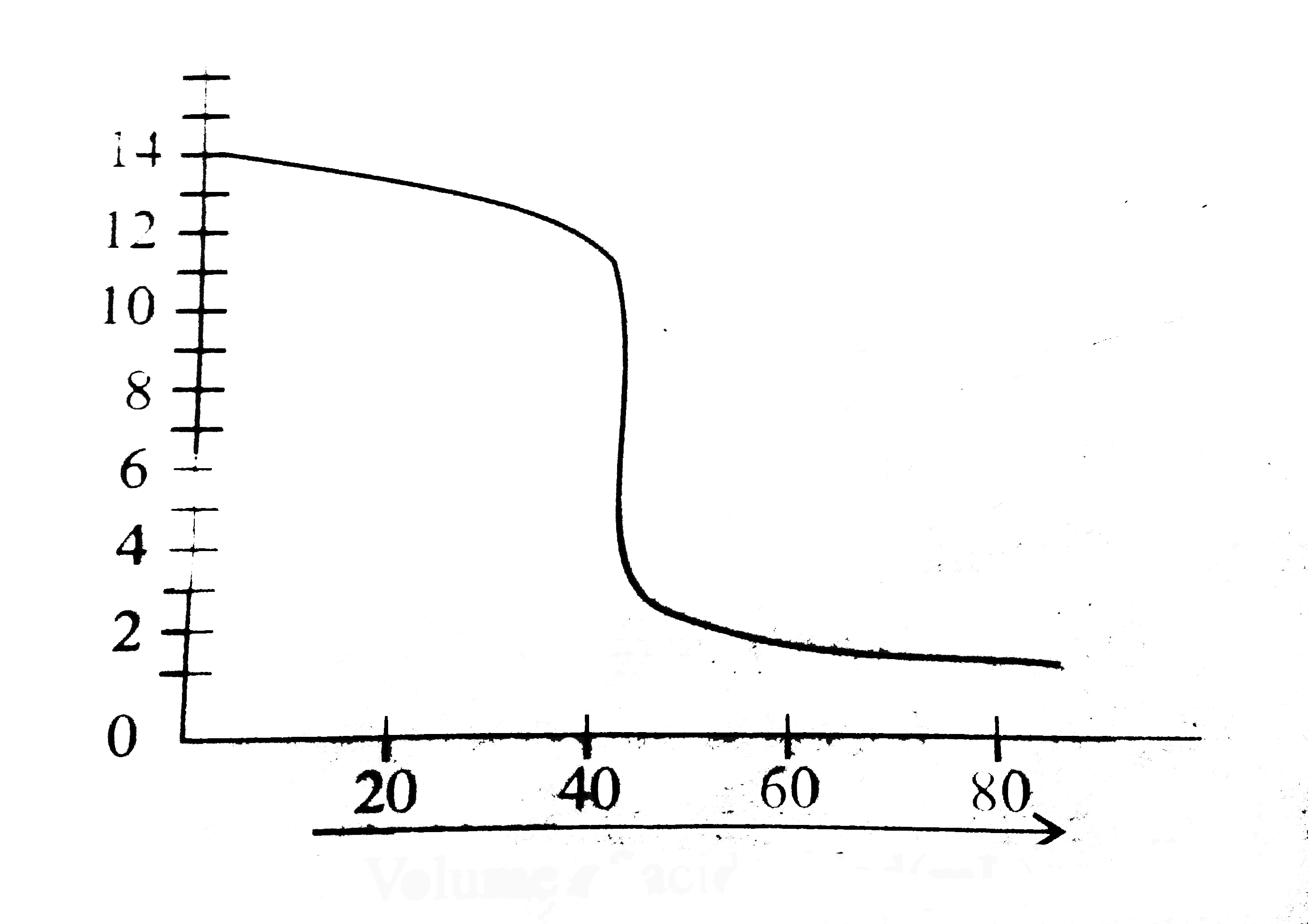An acid-base titration consists of the controlled addition of a dissolved base to a dissolved acid (or the reverse). Acid and base react rapidly to neutralize each other. At the equivalence point, equivalents of reacting substances are equal. The pH during a titration changes every time with a drop of titrant added, but the rate of this change varies enormously. A titration curve, graph of pH as a function of the volume of titrant, displays in detail how the pH changes over the course of an acid base titration. Significantly. the pH changes most rapidly near the equivalence point. The exact shape of a titration curve depends on the KaandKb of acid and base
The pH at equivalence point is: Solution in Telugu
11
7
3
2
The correct Answer is:B
Step by step video, text & image solution for An acid-base titration consists of the controlled addition of a dissolved base to a dissolved acid (or the reverse). Acid and base react rapidly to neutralize each other. At the equivalence point, equivalents of reacting substances are equal. The pH during a titration changes every time with a drop of titrant added, but the rate of this change varies enormously. A titration curve, graph of pH as a function of the volume of titrant, displays in detail how the pH changes over the course of an acid base titration. Significantly. the pH changes most rapidly near the equivalence point. The exact shape of a titration curve depends on the K_(a) and K_(b) of acid and base The pH at equivalence point is: by Chemistry experts to help you in doubts & scoring excellent marks in Class 12 exams.
Topper's Solved these Questions
- BOOK - AAKASH SERIESCHAPTER - IONIC EQUILLIBRIUMEXERCISE - PRACTICE SHEET EXERCISE - IV (LEVEL -II) ( MATRIX MATCHING TYPE QUESTIONS)5videos
IONIC EQUILLIBRIUM
- BOOK - AAKASH SERIESCHAPTER - IONIC EQUILLIBRIUMEXERCISE - ADDITIONAL PRACTICE EXERCISE (PRACTICE SHEET ( ADVANCED))11videos
IONIC EQUILLIBRIUM
- BOOK - AAKASH SERIESCHAPTER - IONIC EQUILLIBRIUMEXERCISE - PRACTICE SHEET EXERCISE - IV (LEVEL -II) (Straight Objective Type Qusestion )6videos
IONIC EQUILLIBRIUM
- BOOK - AAKASH SERIESCHAPTER - GROUP 17 ELEMENTSEXERCISE - EXERCISE - 3.238videos
GROUP 17 ELEMENTS
- BOOK - AAKASH SERIESCHAPTER - METALLURGYEXERCISE - EXERCISE - 7.223videos
METALLURGY
Similar Questions
(Column-I,Column−II),((A)Ag+Cu+2,(P)NH4Cl+NH4OH),((B)Cu+2Mn+2,(Q)H2S/HCl),((C)Fe+2Mg+2,,(R)HCl),((D)Mg+2,Zn+2,NH4OH+NH4Cl+H2S)
08:15View SolutionA solution contains 0.05M of each of NaCl and Na2,CrO4,. Solid AgNO3, is gradually added to it. Whichof the following facts true
(Given: Ksp(AgCl)=1.7×106(−10)M2 and Ksp(Ag2,CrO4,)=1.9×10−12M3:08:15View SolutionThe solubility of solid silver chromate. Ag2CrO4 . is determined in three solvents. Substance Ksp of Ag2CrO4=9×10−12
(I) pure water (ii) 0.1 M AgNO3 (iii) 0.1 M Na2CrO4
Predict the relative solubility of Ag2CrO4 in the three solvents:08:15View SolutionWhy elements of group 17 are called halogens?
08:15View SolutionMetal sulphides occur mainly in rocks, but metal halides occur in lakes and sea. Why ?
03:17View SolutionIn acid-base titration react rapidly to neutralise each other. Equivalence point is a point at which the acid and the base (or oxidising agent and reducing agent) have beem added in equivalent quantities. The end point in the point at which the titration stops. since the purpose of the indicator is to stop the titration close to the point at which the acid and base were added in equivalent quantities, it is important that the equivalent point and the end point be as close as must change colour at a pH close to that of a solution of the salt of the acid base. Singificantly, the pH changes most rapidly near the equivalent point. The exact shape of a titration curve depends on Ka and Kb of acid and base.

The following curve represents titration curve of HCI against KOH. The pH at equivalent point is
Examine the titration curve below and answer the question.
 01:39View Solution
01:39View SolutionIn acid-base titration react rapidly to neutralise each other. Equivalence point is a point at which the acid and the base (or oxidising agent and reducing agent) have beem added in equivalent quantities. The end point in the point at which the titration stops. since the purpose of the indicator is to stop the titration close to the point at which the acid and base were added in equivalent quantities, it is important that the equivalent point and the end point be as close as must change colour at a pH close to that of a solution of the salt of the acid base. Singificantly, the pH changes most rapidly near the equivalent point. The exact shape of a titration curve depends on K_(a) and K_(b) of acid and base. The curve represents the titration of
06:43View SolutionIn acid-base titration react rapidly to neutralise each other. Equivalence point is a point at which the acid and the base (or oxidising agent and reducing agent) have beem added in equivalent quantities. The end point in the point at which the titration stops. since the purpose of the indicator is to stop the titration close to the point at which the acid and base were added in equivalent quantities, it is important that the equivalent point and the end point be as close as must change colour at a pH close to that of a solution of the salt of the acid base. Singificantly, the pH changes most rapidly near the equivalent point. The exact shape of a titration curve depends on K_(a) and K_(b) of acid and base. The suitable indicator for the titration is
04:44View SolutionIn acid-base titration react rapidly to neutralise each other. Equivalence point is a point at which the acid and the base (or oxidising agent and reducing agent) have beem added in equivalent quantities. The end point in the point at which the titration stops. since the purpose of the indicator is to stop the titration close to the point at which the acid and base were added in equivalent quantities, it is important that the equivalent point and the end point be as close as must change colour at a pH close to that of a solution of the salt of the acid base. Singificantly, the pH changes most rapidly near the equivalent point. The exact shape of a titration curve depends on K_(a) and K_(b) of acid and base. The pH at equivalence point is
01:36View SolutionAt half - equivalence point in the titration of weak acid by a strong base , pH = …………..
01:36View SolutionAn acid-base titration consists of the controlled addition of a dissolved base to a dissolved acid (or the reverse). Acid and base react rapidly to neutralize each other. At the equivalence point, equivalents of reacting substances are equal. The pH during a titration changes every time with a drop of titrant added, but the rate of this change varies enormously. A titration curve, graph of pH as a function of the volume of titrant, displays in detail how the pH changes over the course of an acid base titration. Significantly. the pH changes most rapidly near the equivalence point. The exact shape of a titration curve depends on the KaandKb of acid and base
The suitable indicator for this titration will be:01:39View SolutionAn acid-base titration consists of the controlled addition of a dissolved base to a dissolved acid (or the reverse). Acid and base react rapidly to neutralize each other. At the equivalence point, equivalents of reacting substances are equal. The pH during a titration changes every time with a drop of titrant added, but the rate of this change varies enormously. A titration curve, graph of pH as a function of the volume of titrant, displays in detail how the pH changes over the course of an acid base titration. Significantly,the pH changes most rapidly near the equivalence point. The exact shape of a titration curve depends on the K_a and K_b, of acid and base. < The suitable indicator for this titration will be :
01:36View SolutionAn acid-base titration consists of the controlled addition of a dissolved base to a dissolved acid (or the reverse). Acid and base react rapidly to neutralize each other. At the equivalence point, equivalents of reacting substances are equal. The pH during a titration changes every time with a drop of titrant added, but the rate of this change varies enormously. A titration curve, graph of pH as a function of the volume of titrant, displays in detail how the pH changes over the course of an acid base titration. Significantly,the pH changes most rapidly near the equivalence point. The exact shape of a titration curve depends on the K_a and K_b, of acid and base. Which of the titration could it represent?
05:03View SolutionAn acid-base titration consists of the controlled addition of a dissolved base to a dissolved acid (or the reverse). Acid and base react rapidly to neutralize each other. At the equivalence point, equivalents of reacting substances are equal. The pH during a titration changes every time with a drop of titrant added, but the rate of this change varies enormously. A titration curve, graph of pH as a function of the volume of titrant, displays in detail how the pH changes over the course of an acid base titration. Significantly. the pH changes most rapidly near the equivalence point. The exact shape of a titration curve depends on the KaandKb of acid and base
The pH at equivalence point is:02:14View SolutionAn acid-base titration consists of the controlled addition of a dissolved base to a dissolved acid (or the reverse). Acid and base react rapidly to neutralize each other. At the equivalence point, equivalents of reacting substances are equal. The pH during a titration changes every time with a drop of titrant added, but the rate of this change varies enormously. A titration curve, graph of pH as a function of the volume of titrant, displays in detail how the pH changes over the course of an acid base titration. Significantly. the pH changes most rapidly near the equivalence point. The exact shape of a titration curve depends on the KaandKb of acid and base
The pH at equivalence point is:04:11View Solution

